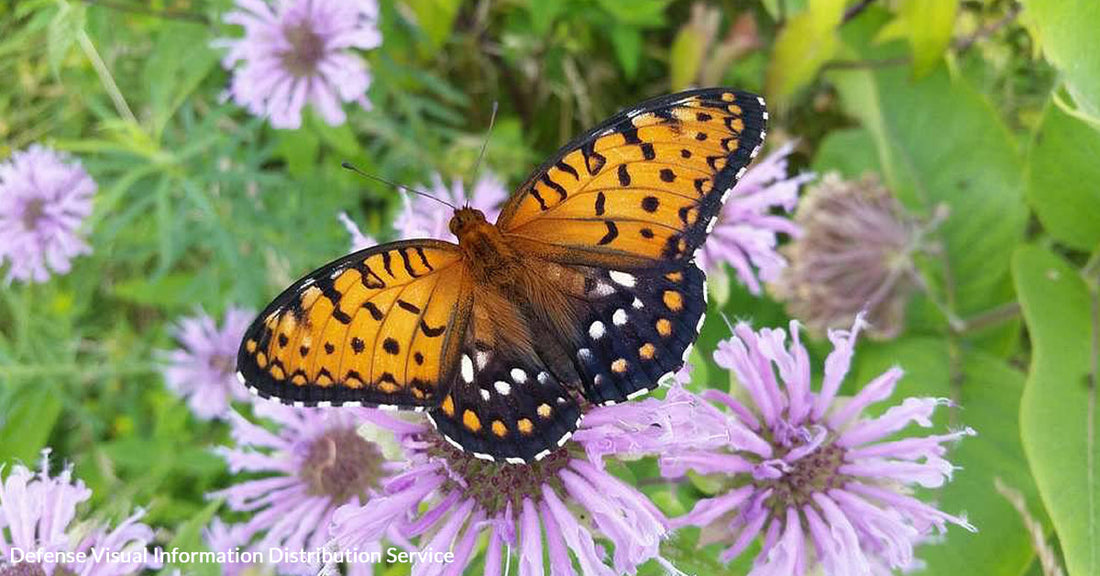Military Base Becomes Final Refuge for Dying Butterfly Species
Matthew Russell
Photo: Defense Visual Information Distribution Service, License: Public Domain
In the heart of Pennsylvania, within the confines of the Fort Indiantown Gap National Guard Training Center, a remarkable struggle for survival unfolds. Here, amidst the military drills and live-fire exercises, lies the last remaining stronghold for the eastern regal fritillary butterfly—a species teetering on the brink of extinction.
This butterfly, once widespread across the eastern United States, now finds itself confined to a 250-acre preserve within the military base. It is a place where the natural world and the military's demands have forged a fragile coexistence, one that may hold the key to the species' future.

A Last Refuge
The eastern regal fritillary is a non-migratory butterfly, similar in size and appearance to the monarch, but with distinctive dark hindwings. This species once thrived across a vast range, from New Brunswick to North Carolina. However, over the last century, it has been pushed to the brink by habitat loss, primarily due to agricultural expansion and urban development. Today, the Fort Indiantown Gap military base is the only place east of the Mississippi River where this butterfly still exists, PennLive reports.
The base’s sprawling grasslands provide the specific conditions the fritillary requires for survival. Here, the butterfly’s life cycle is intricately tied to native violets, which are the sole food source for its caterpillars. As adult butterflies, they rely on the nectar of various flowers, traveling up to 100 miles to find food if necessary. The relationship between the base and the fritillary is an unlikely one.
Fort Indiantown Gap, the most heavily used National Guard training center in the United States, is home to an intense schedule of military training exercises. Yet, within this highly active environment, efforts to conserve the regal fritillary have been remarkably successful, as The Inquirer reports. The base's wildlife management plan includes prescribed burns that prevent the encroachment of woody plants, maintaining the open grasslands that the butterfly needs to thrive.

Threats to Survival
Despite these efforts, the eastern regal fritillary remains highly vulnerable. The butterfly’s habitat is under constant threat from various factors, including climate change, which alters the bloom times of violets and other plants essential to the butterfly's lifecycle. According to the PhillyVoice, drought and other climate-induced changes could disrupt the delicate balance that has allowed the butterfly to survive at Fort Indiantown Gap.
The loss of grasslands elsewhere in the fritillary’s historic range further compounds the problem. The fragmented nature of the butterfly's habitat at Fort Indiantown Gap means that there is no room for error. If anything were to happen to this last refuge, the species could be lost forever. Moreover, the military's activities, while carefully managed to protect the butterflies, still pose risks. Military vehicles and training exercises could inadvertently damage the fragile habitat, despite the base’s efforts to minimize such impacts, PennLive reports.

The Importance of Conservation
The significance of preserving the eastern regal fritillary extends beyond just saving a single species. Butterflies are critical pollinators, and their decline can have cascading effects on the ecosystems they inhabit, WildEarth Guardians notes.
The loss of the regal fritillary would not only mean the extinction of a beautiful and unique species but could also signal broader environmental degradation. Recognizing this, the U.S. Fish and Wildlife Service (USFWS) recently proposed listing the eastern regal fritillary as an endangered species under the Endangered Species Act (ESA). This designation would provide the butterfly with much-needed legal protections and could lead to increased funding and resources for conservation efforts.
The proposal also includes listing the western subspecies of the regal fritillary as threatened. Unlike the eastern subspecies, the western regal fritillary is found in multiple states across the Great Plains and Midwest, PennLive reports. However, it too faces significant threats from habitat loss and climate change. Protecting both subspecies under the ESA would be a crucial step in ensuring their survival.

A Race Against Time
The future of the eastern regal fritillary remains uncertain. The USFWS’s proposal to list the butterfly as endangered is a critical move, but it comes after years of delay. Conservationists have long argued that more immediate action is needed to prevent the butterfly's extinction. As the public comment period on the proposed listing continues, it is clear that time is of the essence.
At Fort Indiantown Gap, the delicate balance between military readiness and conservation efforts must continue. The base’s commitment to preserving the regal fritillary is commendable, but the challenges are immense. The survival of this butterfly will depend on continued vigilance, both in protecting its last remaining habitat and in addressing the broader environmental issues that threaten its existence.
Click below and support efforts to save this species from extinction!
Matthew Russell is a West Michigan native and with a background in journalism, data analysis, cartography and design thinking. He likes to learn new things and solve old problems whenever possible, and enjoys bicycling, spending time with his daughters, and coffee.




















